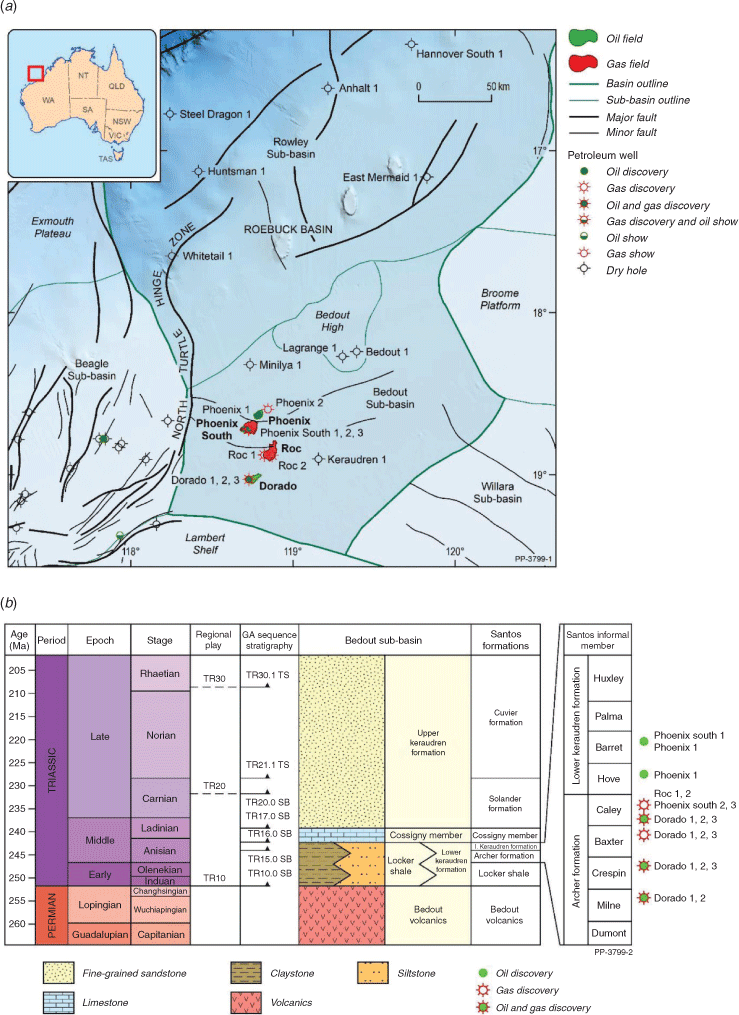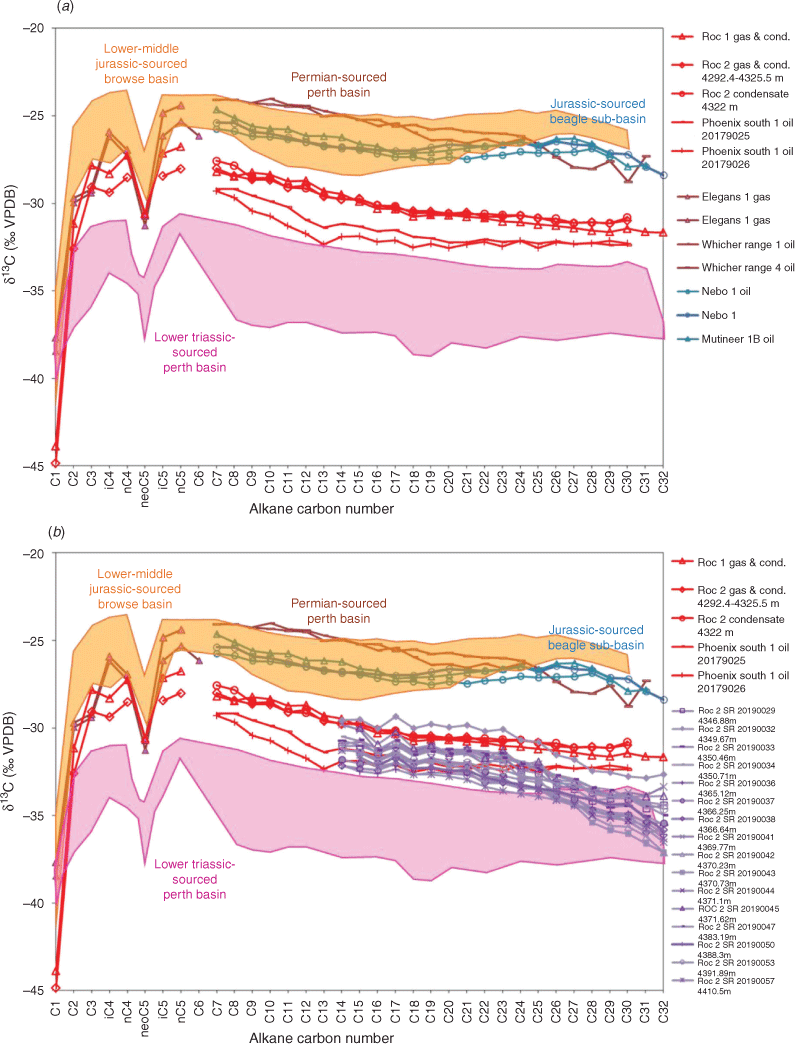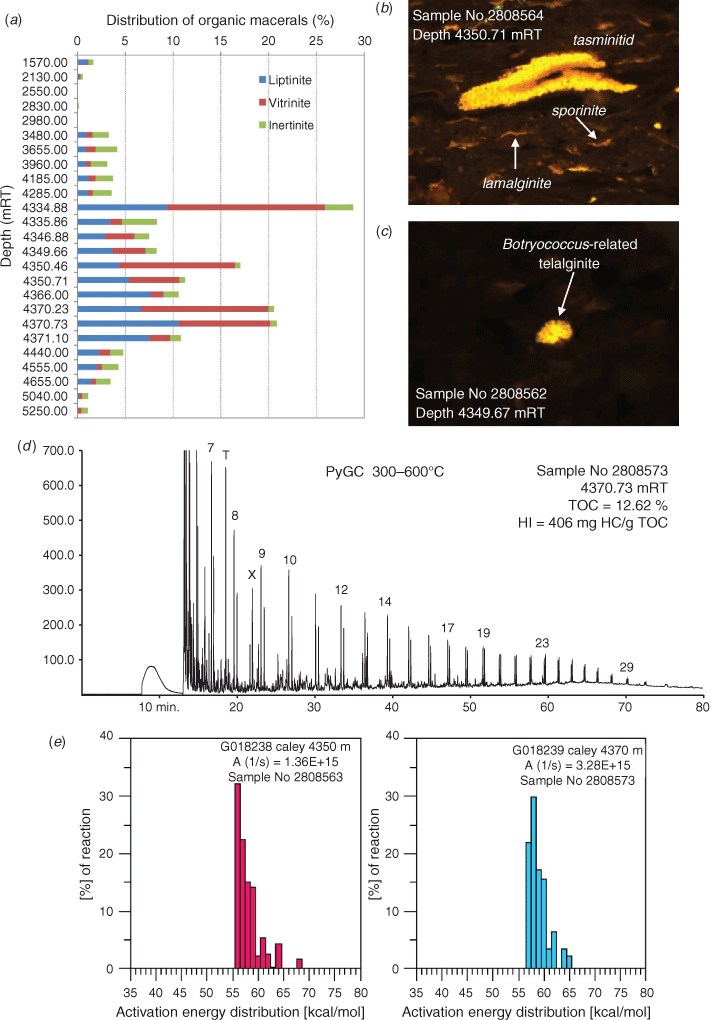Geochemical evidence for a new Triassic petroleum system on the western margin of Australia
Emmanuelle Grosjean A B , Dianne S. Edwards A , Nadege Rollet A , Christopher J. Boreham A , Duy Nguyen A and Tamara Buckler AA Geoscience Australia, GPO Box 378, Canberra, ACT 2601, Australia.
B Corresponding author. Email: emmanuelle.grosjean@ga.gov.au
The APPEA Journal 61(2) 616-625 https://doi.org/10.1071/AJ20027
Accepted: 16 March 2021 Published: 2 July 2021
Journal Compilation © APPEA 2021 Open Access CC BY
Abstract
The unexpected discovery of oil in Triassic sedimentary rocks of the Phoenix South 1 well on Australia’s North West Shelf (NWS) has catalysed exploration interest in pre-Jurassic plays in the region. Subsequent neighbouring wells Roc 1–2, Phoenix South 2–3 and Dorado 1–3 drilled between 2015 and 2019 penetrated gas and/or oil columns, with the Dorado field containing one of the largest oil resources found in Australia in three decades. This study aims to understand the source of the oils and gases of the greater Phoenix area, Bedout Sub-basin using a multiparameter geochemical approach. Isotopic analyses combined with biomarker data confirm that these fluids represent a new Triassic petroleum system on the NWS unrelated to the Lower Triassic Hovea Member petroleum system of the Perth Basin. The Bedout Sub-basin fluids were generated from source rocks deposited in paralic environments with mixed type II/III kerogen, with lagoonal organofacies exhibiting excellent liquids potential. The Roc 1–2 gases and the Phoenix South 1 oil are likely sourced proximally by Lower–Middle Triassic TR10–TR15 sequences. Loss of gas within the Phoenix South 1 fluid due to potential trap breach has resulted in the formation of in-place oil. These discoveries are testament to new hydrocarbon plays within the Lower–Middle Triassic succession on the NWS.
Keywords: Roebuck Basin, Bedout Sub-basin, fluids, source rocks, organic geochemistry, biomarkers, isotopes, Triassic, Keraudren Formation.
Introduction
In 2014, the surprise discovery of oil in Phoenix South 1 on Australia’s North West Shelf (NWS) heralded the Bedout Sub-basin as a new oil province in Australia (Fig. 1a). The Dorado oil field, discovered in 2018 and located about 40 km south of Phoenix South 1, is one of the largest oil resources found in Australia in decades (Weller and Amiribesheli 2018; Cockerill 2020) and confirms the magnitude of the resources in the Bedout Sub-basin. However, whether these discoveries represent a new oil province is challenged by the presence of gas in the Greater Phoenix area wells, Roc 1–2, Phoenix South 2–3 and Dorado 1–3.

|
To better assess the potential for finding similar plays elsewhere on the margin, it is essential to understand the source of the oils and gases in the greater Phoenix area, which is accomplished using a geochemical approach. Analyses of fluids provide information on the source rock they derive from, including kerogen type, age and maturity at the time of hydrocarbon generation. Oil–gas–source correlations using isotopic and molecular data provide insights into the most likely source rock from which the fluids of the Bedout Sub-basin derive.
Samples and methods
The oils, natural gas and rock samples analysed in this study for bulk isotopic and biomarker compositions are listed in Table 1. The Phoenix South 1 oils were recovered from the Middle Triassic Barret Member between TR15.0_SB and TR16.0_SB, whereas the Roc 1–2 gases and condensates were taken from the Lower to Middle Triassic Caley Member between TR10.0_SB and TR15.0_SB (Thompson et al. 2018; Rollet et al. 2019) (Fig. 1b). The methods and data have been reported in Grosjean et al. (2019a, 2019b, 2019c, 2020a). At the time of this study, fluids from the recently drilled Dorado wells were not yet available for analysis but will be included in further work.

|
Oil and gas geochemistry of Bedout Sub-basin fluids
Roc 1–2 both encountered rich gas condensates with condensate-to-gas ratios of 50.5 and 55.8 bbl/mmscf, respectively. While methane is the dominant component of these natural gases (Grosjean et al. 2019b), they are considered wet gases with C1/(C1–C5) of 82.8%, where wet gases are defined by this ratio as being <98% (Tissot and Welte 1984).
The Phoenix South 1 oils and Roc 1–2 condensates are light fluids (API gravity 43–49°), low in sulfur (S = 0.01–0.08 wt.%) and non-biodegraded. The low gas-to-oil ratios in the range 1691–1764 scf/bbl for the Phoenix South 1 oils are inconsistent with an API > 45°, implying that the oils are undersaturated with respect to gas (Murray and He 2020). Based on vitrinite reflectance equivalent (VREQ-5) data derived from a proprietary combination of aromatic hydrocarbons analysed by GC/MS-MS QQQ at GeoMark Research, the Roc 1–2 condensates are more thermally mature (mean VREQ-5 = 1.16%) than the Phoenix South 1 oils (VREQ-5 = 0.98%) generated at peak oil maturity. The pristane-to-phytane (Pr/Ph) ratios of the Phoenix South 1 oils and Roc 1–2 condensates are in excess of 2.5 (Table 1), indicative of a suboxic/oxic depositional environment for the source rock. Terpanes and steranes distributions reveal mixed marine-terrestrial inputs to the organic matter and a clastic source rock. There is no increased abundance of C33 alkylcyclohexane in these fluids, a biomarker diagnostic for the end-Permian mass extinction event and prevalent in Lower Triassic-sourced Perth Basin oils (Grosjean et al. 2011 and references therein). The low relative amount of retene, a polyaromatic compound likely derived from Araucariacae conifers that evolved during the Jurassic (Alexander et al. 1988), is in agreement with a pre-Jurassic age. The carbon isotopic composition (δ13C) of the saturated hydrocarbon fractions ranges from –30.2 to –29.6‰, which is within the range of values observed globally for crude oils derived from Triassic source rocks (Andrusevich et al. 1998).
An effective tool for understanding the potential source of gases and oils is to compare the compound-specific isotopic analyses of linear alkanes of the fluids with those of the source rocks from which they may be derived. Carbon isotopic values of alkanes for the fluids in the greater Phoenix area wells fall between the Lower–Middle Jurassic fluids from the Browse Basin, the Jurassic fluids from the Beagle Sub-basin, the Permian fluids of the Perth Basin and the Lower Triassic fluids of the Perth Basin (Fig. 2a). Linear alkanes of the Phoenix South 1 oils are on average 1.5‰ more depleted in 13C than the Roc 1–2 condensates, which is in agreement with a lower thermal maturity (Clayton and Bjorøy 1994). The alkane carbon isotopic profiles of the Roc 2 gas/condensate pair follow a smooth continuum inferring cogeneration by the same source rock at the same maturity (Boreham et al. 2001).

|
Source rock geochemical characteristics
Based on the stratigraphic emplacement of the oil and gas discoveries within Lower to Middle Triassic reservoirs between TR10.0_SB and TR17.0_SB (Fig. 1b), Lower to Middle Triassic rocks were investigated for their hydrocarbon source potential using publicly available Rock-Eval pyrolysis data to identify the most suitable candidates for oil to source correlations. Sediments between TR10.0_SB and TR15.0_SB were deposited in a fluvial-deltaic environment with occasional minor marine influences (Abbott et al. 2019; Rollet et al. 2019). In the Bedout Sub-basin, sedimentary rocks that have available geochemical data have a mean total organic carbon (TOC) content of 3.1 wt.% and a mean genetic potential S1 + S2 of 9.4 mg hydrocarbons (HC)/g rock, exhibiting good to excellent hydrocarbon-generating potential. With a mean hydrogen index (HI) of 229 mg HC/g TOC, these source rocks consist mainly of mixed type II/III kerogens and organofacies D/E in the kerogen classification by Pepper and Corvi (1995), capable of generating both oil and gas. However, about one-fifth of the rocks analysed within the Caley Member in Roc 2 stand out as excellent oil-prone source rocks having TOC > 4 wt.% (up to 23.2 wt.%) and HI > 300 mg HC/g TOC (Rollet et al. 2019; Grosjean et al. 2019a). Caley Member shales are enriched in the maceral liptinite, an oil-prone source rock organic component. Liptinite in these shales consists of a mixture of algal-derived lamalginite, marine plankton tasmanitids, brackish–freshwater algae Botryococcus-related telalginite and the land–plant maceral sporinite (Fig. 3a–c) (Ranasinghe and Crosdale 2019). The combination of terrestrial and freshwater/marine algal macerals suggests a deltaic to lagoonal environment, which is supported by detailed sedimentological, ichnological and palynological observations on Roc 2 cores (Allgöwer and Lignum 2019). Pyrolysis products from pyrolysis–gas chromatography are dominated by n-alkenes/n-alkanes pairs extending to long chain lengths, reflecting a prevailing algal contribution and confirming the oil-prone nature of the kerogen (Fig. 3d). The high abundance of aromatic and phenolic compounds among the pyrolysis products indicates a significant land–plant contribution (Larter 1985; Mahlstedt and Horsfield 2019). Bulk kinetics show a narrow activation energy (Ea) distribution (Fig. 3e) consistent with the cracking of mixed aquatic–terrestrial organic matter and petroleum generation occurring between 145°C and 210°C for a geologic heating rate of 3 K/Ma.
With VREQ-5 in the range 0.78–0.81%, the Caley Member source rocks analysed in Roc 2 are not as thermally mature as the fluids. Biomarker distributions are consistent with a mixed marine to terrestrial clastic depositional environment. The carbon isotopic compositions of C14–C32 linear alkanes show values between –29 and –38‰ (Grosjean et al. 2020b), with alkanes isotopic profiles nested in between those of the Lower Triassic Perth Basin oils and the Jurassic-sourced fluids of the Browse Basin, similar to the fluids in Roc 1–2 and Phoenix South 1 (Fig. 2b).
With a mean TOC content of 1.4 wt.% and HI in the range 33–331 mg HC/g TOC in wells of the Bedout Sub-basin, fluvio-deltaic sedimentary rocks between TR15.0_SB and TR16.0_SB are not as organic-rich as the sequence below but the organic matter consists of mixed type II/III kerogen adequately capable of generating oil and gas (Rollet et al. 2019).
A new Triassic petroleum system
Biomarker and isotopic data of the Bedout Sub-basin fluids analysed in this study suggest sourcing from a clastic source rock consistent with a Triassic age and deposition under suboxic/oxic conditions with mixed marine and terrestrial organic matter inputs. The fluid geochemistry in Phoenix South 1 and Roc 1–2 indicates that they represent a new Triassic petroleum system on the western margin of Australia unrelated to the Lower Triassic petroleum system of the Perth Basin. The inferred depositional environment for the source rock is in agreement with derivation from type II/III fluvio-deltaic to lagoonal source rocks present in the Bedout Sub-basin between TR10.0_SB and TR16.0_SB (Rollet et al. 2019). Caley Member source rocks from the Roc 2 well are too immature to have generated the Phoenix South 1 and Roc 1–2 fluids but exhibit carbon isotopic ratios and biomarker distributions correlating broadly with those of the fluids. Sedimentary packages between TR10.0_SB and TR16.0_SB extend to the northwest of the Phoenix South and Roc wells, where they are anticipated to reside in fully mature generative kitchens and provide the effective source of the recovered fluids. The difference in thermal maturity between the Phoenix South 1 oil reservoired in the Barret Member (VREQ-5 = 0.98%) and the Roc 1–2 condensates (mean VREQ-5 = 1.16%) in the deeper Caley Member reservoir suggests derivation from discrete source pods of similar character but of different thermal maturities with the occurrence of stacked source/reservoir pairs separated by intraformational seals (Thompson 2020). This scenario is supported by the presence of a regionally continuous, fine-grained Hove Member providing a top and lateral seal to the Roc and Phoenix South discoveries (Thompson 2020).
The finding of both oil and rich gas condensates in wells of the greater Phoenix area is consistent with hydrogen-rich source rocks of D/E facies. Significantly, D/E sourced fluids are the most susceptible to phase separation as the generation window is close to saturation pressure, which can lead to dual-phase (oil and gas) accumulations (He and Murray 2019). The fluid phase is also controlled by processes such as spill-fill, leakage and in-reservoir alteration (Murray and He 2020). The Phoenix South 1 oil accumulation is undersaturated with respect to gas, which suggests that loss of gas has enriched the remaining fluid in heavy hydrocarbons resulting in the formation of oil. Supplementary work on the Dorado fluids will further improve the understanding of this significant new petroleum system on the NWS of Australia.
Conflicts of interest
All authors confirm there are no conflicts of interest.
Declaration of funding
No funding from external organisations was received for this research.
Acknowledgements
We would like to thank Geoscience Australia’s Organic Geochemistry and Isotope Laboratory and the Minerals, Energy and Groundwater Division Information Management team for provision and management of data. George Jakovceski (Geoscience Australia) and Paul Stephenson (WA Department of Mines and Petroleum) facilitated access to fluids and drill core held in the National Offshore Petroleum Data and Core Repository. Steve Abbott and Chris Evenden (Geoscience Australia) are thanked for their assistance in drafting figures. Chris Nicholson and Junhong Chen are thanked for their constructive reviews. This abstract is published with the permission of the CEO, Geoscience Australia © Commonwealth of Australia (Geoscience Australia) 2021.
References
Abbott, S., Orlov, C., Bernadel, G., Rollet, N., Nguyen, D., Gunning, M.-E., and Nicholson, C. (2019). Palaeogeographic evolution of the Triassic succession, central North West Shelf. In ‘Australasian Exploration Geoscience Conference, 2–5 September 2019’. (Perth, Western Australia.)Alexander, R., Larcher, A. V., Kagi, R. I., and Price, P. L. (1988). The use of plant derived biomarkers for correlation of oils with source rocks in the Cooper/Eromanga Basin System, Australia. The APEA Journal 28, 310–324.
| The use of plant derived biomarkers for correlation of oils with source rocks in the Cooper/Eromanga Basin System, Australia.Crossref | GoogleScholarGoogle Scholar |
Allgöwer, A., and Lignum, J. (2019). Fine-scale variations in distributary mouth-bar morphology in the Middle Triassic Caley Member of the Bedout Sub-basin, Western Australia. In ‘The Sedimentary Basins of Western Australia V: Proceedings of the Petroleum exploration Society of Australia Symposium’. (Eds M. Keep and S. J. Moss.) pp. 1–23. (Perth, WA.)
Andrusevich, V. E., Engel, M. H., Zumberge, J. E., and Brothers, L. A. (1998). Secular, episodic changes in stable carbon isotope composition of crude oils. Chemical Geology 152, 59–72.
| Secular, episodic changes in stable carbon isotope composition of crude oils.Crossref | GoogleScholarGoogle Scholar |
Boreham, C. J., Hope, J. M., and Hartung-Kagi, B. (2001). Understanding source, distribution and preservation of Australian natural gas: a geochemical perspective. The APPEA Journal 41, 523–547.
| Understanding source, distribution and preservation of Australian natural gas: a geochemical perspective.Crossref | GoogleScholarGoogle Scholar |
Clayton, C. J., and Bjorøy, M. (1994). Effect of maturity on 13C/12C ratios of individual compounds in North Sea oils. Organic Geochemistry 21, 737–750.
| Effect of maturity on 13C/12C ratios of individual compounds in North Sea oils.Crossref | GoogleScholarGoogle Scholar |
Cockerill, I. (2020). PESA Australian exploration review 2019. The APPEA Journal 60, 348–359.
| PESA Australian exploration review 2019.Crossref | GoogleScholarGoogle Scholar |
Grosjean, E., Boreham, C. J., Jones, A., Kennard, J., Mantle, D., and Jorgensen, D. C. (2011). Geochemical study significantly extends the distribution of effective basal Kockatea Shale source rocks in the offshore northern Perth Basin. PESA Journal. WA Supplement 115, 21–25.
Grosjean, E., Edwards, D. S., Hong, Z., Jinadasa, N., and Buckler, T. (2019a). TOC and Rock-Eval pyrolysis data from the well Roc 2, Roebuck Basin, Australia. Record 2019/12. (Geoscience Australia, Canberra.)
Grosjean, E., Edwards, D. S., Hong, Z., Jinadasa, N., Sohn, J., and Buckler, T. (2019b). Geochemical compositions of natural gases from the wells Roc 1 and Roc 2, Roebuck Basin, Australia. Record 2019/11. (Geoscience Australia, Canberra.)
Grosjean, E., Edwards, D. S., Sohn, J., Hong, Z., Jinadasa, N., and Buckler, T. (2019c). Organic geochemical data release for Phoenix South 1 ST2 oils, Bedout Sub-basin, Australia. Record 2019/13. (Geoscience Australia, Canberra.)
Grosjean, E., Edwards, D. S., Hong, Z., Jinadasa, N., Buckler, T., and Abbott, S. (2020a). Organic geochemical data release for petroleum fluids of the Roc 1 and 2 wells, Bedout Sub-basin, Australia. Record 2020/021. (Geoscience Australia, Canberra.)
Grosjean, E., Edwards, D. S., Hong, Z., Jinadasa, N., Sohn, J., Buckler, T., and Abbott, S. (2020b). Organic geochemical data release for source rocks of the Roc 2 well, Bedout Sub-basin, Australia. Record 2020/018. (Geoscience Australia, Canberra.)
He, Z., and Murray, A. (2019). Top down petroleum system analysis: exploiting geospatial patterns in the properties of hydrocarbon fluids. 2019 AAPG Annual Convention and Exhibition, San Antonio, Texas, May 19–22 2019. Search and Discovery Article #42421.
Larter, S. (1985). Integrated kerogen typing in the recognition and quantitative assessment of petroleum source rocks. In ‘Petroleum Geochemistry in Exploration of the Norwegian Shelf’. pp. 269–286. (Springer.)
Mahlstedt, N., and Horsfield, B. (2019). Petroleum generation and PhaseKinetics characteristics of two source rock kerogen samples from the Caley Member, Australia. Report prepared for Geoscience Australia. GEOS4 Report Nr. 20190618. Destructive Analysis Report 1892.
Marshall, N., and Lang, S. (2013). A new sequence stratigraphic framework for the North West Shelf, Australia. In ‘The Sedimentary Basins of Western Australia 4: Proceedings PESA Symposium, Perth’. (Eds M. Keep and S. J. Moss.) pp. 1–32.
Murray, A., and He, Z. (2020). Oil vs. Gas: What are the Limits to Prospect-Level Hydrocarbon Phase Prediction? 2019 AAPG Hedberg Conference, The Evolution of Petroleum Systems Analysis, Houston, Texas, March 4–6, 2019. Search and Discovery Article #42513.
Ogg, J. G., Ogg, G. M., and Gradstein, F. M. (2016). ‘A Concise Geologic Time Scale: 2016.’ (Elsevier).
Pepper, A. S., and Corvi, P. J. (1995). Simple kinetic models of petroleum formation. Part I: oil and gas generation from kerogen. Marine and Petroleum Geology 12, 291–319.
| Simple kinetic models of petroleum formation. Part I: oil and gas generation from kerogen.Crossref | GoogleScholarGoogle Scholar |
Ranasinghe, S. P., and Crosdale, P. J. (2019). Report on source rock type, maturation levels and hydrocarbon potential of a suite of samples from Roc 2 well, Western Australia. Report prepared for Geoscience Australia. Destructive Analysis Report 1892.
Rollet, N., Grosjean, E., Edwards, D. S., Kempton, R. H., Nguyen, D., Abbott, S., Orlov, C., Bernadel, G., and Nicholson, C. (2019). Triassic petroleum systems on the central North West Shelf – Learnings from the greater Phoenix area seismic mapping and geochemical studies. In ‘Australasian Exploration Geoscience Conference, 2–5 September 2019’. (Perth, Western Australia.)
Thompson, M. (2020). Dorado discovery – unlocking a major new oil and gas play in the Bedout Sub-basin. The APPEA Journal 60, 778–783.
| Dorado discovery – unlocking a major new oil and gas play in the Bedout Sub-basin.Crossref | GoogleScholarGoogle Scholar |
Thompson, M., Wehr, F., Woodward, J., Minken, J., D’Orazio, G., Fernandes, F., Kongowoin, M., Hansen, L., Kuek, D., and Fabrici, R. (2018). Recent exploration results in the Lower Triassic, Bedout Sub-basin: Australia’s next petroleum province? The APPEA Journal 58, 871–877.
| Recent exploration results in the Lower Triassic, Bedout Sub-basin: Australia’s next petroleum province?Crossref | GoogleScholarGoogle Scholar |
Thompson, M., Woodward, J., Minken, J., and Ryan, R. (2019). Unravelling the Lower Keraudren petroleum system in the Bedout Sub-basin: some early observations. In ‘The Sedimentary Basins of Western Australia V: Proceedings of the Petroleum exploration Society of Australia Symposium’. (Eds M. Keep and S. J. Moss.) pp. 1–20. (Perth, WA.)
Tissot, B. P., and Welte, D. H. (1984). ‘Petroleum Formation and Occurrence’. (Springer-Verlag.)
Weller, A., and Amiribesheli, S. (2018). Confronting the elephant: Dorado-1 and the prospectivity of the Offshore Canning area. PESA News , 57–61.

Emmanuelle Grosjean is a petroleum geochemist at Geoscience Australia working in the Minerals, Energy and Groundwater Division. She applies organic geochemistry to assess the hydrocarbon prospectivity of Australia’s offshore and onshore sedimentary basins. She has recently been involved in building database systems to release petroleum geochemical data via the portal https://portal.ga.gov.au. She holds a doctorate degree in organic chemistry from the University of Strasbourg, France. Before joining Geoscience Australia in 2005, she worked on the Precambrian petroleum systems of the South Oman Salt Basin as a post-doctoral associate at the Massachusetts Institute of Technology. |

Dianne Edwards is a senior petroleum geochemist at Geoscience Australia working in the Minerals, Energy and Groundwater Division. Her scientific focus is on defining the petroleum systems of Australia’s petroliferous basins including both conventional and unconventional play types. She is involved in building database systems to release petroleum geochemical data via the portal https://portal.ga.gov.au. She received her BSc (Hons) degree in geology and MSc in organic petrology and organic geochemistry from the University of Newcastle-upon-Tyne (UK). She was awarded a PhD from the University of Adelaide in 1996. In 2018, she received the Australian Organic Geochemistry Conference Medal for lifetime achievement in the field of organic geochemistry. She is a member of PESA. |

Nadège Rollet is a senior geoscientist in Geoscience Australia’s Minerals, Energy and Groundwater Division. She is currently investigating the petroleum prospectivity of the central North West Shelf of Australia. She obtained a MSc and a PhD (1999) in geology and geophysics from the University of Paris – Pierre et Marie Curie (France). Her studies focused on the structural framework and geodynamics of the Ligurian Sea (western Mediterranean). Since joining Geoscience Australia, she has contributed to marine surveys around Australia, assessments of the petroleum prospectivity, seepage studies and CO2 storage of Australian sedimentary basins. She is a member of PESA. |

Christopher J. Boreham is a principal petroleum geochemist at Geoscience Australia working in the Minerals, Energy and Groundwater Division. He obtained his BSc (Hons) in chemistry from the University of Queensland and was awarded a PhD in chemistry at ANU. He has worked at Geoscience Australia for four decades. He has a wide experience in the application of organic geochemistry to the evolution of oil and gas in Australian sedimentary basins. He has recently extended these geochemical studies to unconventional petroleum (coal seam methane, shale gas and oil), helium, hydrogen and abiogenic hydrocarbons, as well as being involved in CO2CRC’s studies on the injection of CO2 into a depleted natural gas field and a saline aquifer. In 2010, he received the Australian Organic Geochemistry Conference Medal for lifetime achievement in the field of organic geochemistry. He is a member of PESA. |

Duy (Victor) Nguyen is a senior petroleum engineer at Geoscience Australia working in the Minerals, Energy and Groundwater Division where he has extensive expertise on the Browse, Roebuck and Otway basins. He holds BE and ME (petroleum engineering) degrees from the University of New South Wales. As part of his degrees, he researched the techno-economics of CO2 geological sequestration in Australia. He has five years of oil and gas industrial experience working for Schlumberger in Australia, Malaysia, India, the Middle East and Africa. Since 2009, he has worked on the assessment of the CO2 geological storage potential of the Bonaparte, Gippsland and Browse basins. |

Tamara Buckler is a data manager at Geoscience Australia working in the Minerals, Energy and Groundwater Division. She has worked extensively with the maintenance and upgrade of the oracle databases since commencing work with the Australian Geological Survey Organisation in 1996. She has completed Data Management and Oracle training and manages several corporate Oracle databases, including the petroleum geochemistry database. She is involved in building database systems to release petroleum geochemical data via the portal https://portal.ga.gov.au. |



